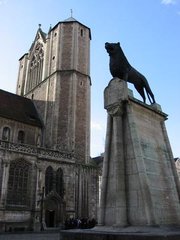Braunschweig (city)
|
|
- Braunschweig may also refer to the administrative region of Germany. See Braunschweig (region). Brunswick may refer to several geographic locations, companies and products. See Brunswick (disambiguation).
Braunschweig-Position.png
Braunschweig [ˈbraunʃvaik] (English: Brunswick) is a city of 245,500 people (as of December 31, 2004), located in Lower Saxony, Germany. It is located north of the Harz mountains at the farthest navigable point of the Oker river, which connects to the North Sea via the rivers Aller and Weser.
| Contents |
History
The date and circumstances of the town's foundation are unknown. Legend says that Brunswick was founded by Bruno II (died before 1017 AD), a Saxon count. A wik was a place where merchants rested and stored their goods. Brunswick = Bruno's wik was an ideal resting-place, as it lay by a ford across the Oker River.
Burg_Dankwarderode.jpg
Duke Henry the Lion (German: Heinrich der Löwe, born 1129/30, died 06.08.1195) made B. the capital of his state and built Brunswick Cathedral. He got so powerful that he dared to refuse military aid to emperor Frederick I Barbarossa, which led to his condemnation and fall.
Brunswick was a member of the Hanseatic League from the 13th to the middle of the 17th century. In the 18th century Brunswick was not only a political, but also a cultural centre. Emilia Galotti by Lessing and Goethe's Faust were played for the first time in Brunswick.
Brunswick was a duchy until 1918, and afterwards a state within the Weimar Republic. It achieved an inglorious fame by making Adolf Hitler a German citizen, which allowed him to candidate for the German Reichstag and become Head of Government (Reichskanzler). Hitler was employed by the Brunswick State Government in February 1932 and thereby obtained German citizenship. The later site selection of the Volkswagen plant in nearby Wolfsburg (Fallersleben) was likely a thank-you gift for this granting of citizenship.
During World War II Brunswick was severely damaged by Anglo-American aerial attacks. The air raid on October 15, 1944 destroyed most of the city of Brunswick, which consisted of half-timbered houses, and also most of the churches. Only Brunswick Cathedral, which was changed into a National shrine (German: Nationale Weihestätte) by the Nazi-Government, withstood the bombs. After the war, Brunswick Cathedral was turned into a Protestant church again. A small section of the old centre of town did survive the bombing, and is quite distinctive.
Historical population
1811: 27,600 inhabitants
1830: 35,300
1849: 39,000
1880: 75,000
1890: 100,000
1900: 128,200
1925: 146,900
Sights
- Castle (built by Henry the Lion, 12th century)
- Cathedral (built from 1173; Henry the Lion is buried here)
- Altstadtmarkt ("old town market"), surrounded by the old town hall and the Martinikirche (church Saint Martin, 1195)
- Aegidienkirche (church Saint Aegidius, 1115), with an adjoining monastery, which is today a museum
Braunschweig,_Happy_RIZZI_House.jpg
- The "Rizzi-Haus", a highly distinctive, cartoonish office building designed by architect James Rizzi.
- The "Herzog Anton Ulrich Museum", an important art museum and the oldest museum in Germany (founded 1754)
Recommended Day Trips:
- Hildesheim: beautiful medieval town famous for its UNESCO-cultural heritage Cathedrals, market place and old half-timbered houses
- Hamelin: the beautiful town is famous for the folk tale of the Pied Piper of Hamelin
- Wolfenbüttel: the Residenzstadt (residential city) of the Dukes of Brunschweig-Lüneburg for several centuries, Wolfenbüttel (http://www.wolfenbuettel-tourismus.de/cgi-bin/main.pl?il=m_215&site=search&tle=m_21&user=default) is home to a Wasserburg (castle surrounded by a moat) and the Bibliotheca Augusta (Herzog-August Bibliothek, or the Duke August library (http://www.hab.de/index-e.htm)) housing the largest collection of medieval manuscripts in Europe. The city is historically important also for its numerous half-timber houses, many of which date back several centuries since Wolfenbüttel was left largely untouched by WWII.
Miscellaneous
Brunswick has been an important industrial area. Today it is known for its University (website) (http://www.tu-brunswick.de/) and research institutes, mainly the Federal Agricultural Research Centre (English website) (http://www.fal.de/en/) and the PTB, the Physikalisch-Technische Bundesanstalt, the national institute of natural and engineering sciences and the highest technical authority for metrology and physical safety engineering of the Federal Republic of Germany (English website) (http://www.ptb.de/index_en.html).
Also located in Brunswick is the "Martino-Katharineum" (website) (http://www.mk-bs.de), a secondary school founded in 1415. It had such famous pupils as Carl Friedrich Gauss, Hoffmann von Fallersleben, Richard Dedekind and Louis Spohr.
Brunswick is the home of two piano companies, both known worldwide for the high quality of their instruments: Schimmel and Grotrian-Steinweg (cf. Steinway). Both companies were founded in the 19th century.
Brunswick is famous for Till Eulenspiegel, a medieval mixture of a jester and a Robin Hood who played many practical jokes on its citizens. It also had - and still has - many breweries, and still a very peculiar kind of beer is made called Mumme, first quoted in 1390, a malt-extract that was shipped all over the world.
Near Braunschweig at Cremlingen-Abbenrode, there is a large medium wave transmitter, which transmits the program of "Deutschlandfunk" on 756 kHz, the transmitter Cremlingen.
External links
- Official Brunswick web site (English) (http://www.brunswick.de/english/index.html)
- Technical University at Brunswick (http://www.tu-brunswick.de/)
- Braunschweiger Feldkorps (re-enactment society) (http://www.braunschweiger-feldkorps.de)de:Braunschweig
eo:Braunschweig fr:Brunswick (ville) it:Braunschweig ka:ბრაუნშვაიგი nl:Braunschweig no:Braunschweig sl:Braunschweig fi:Braunschweig sv:Braunschweig


